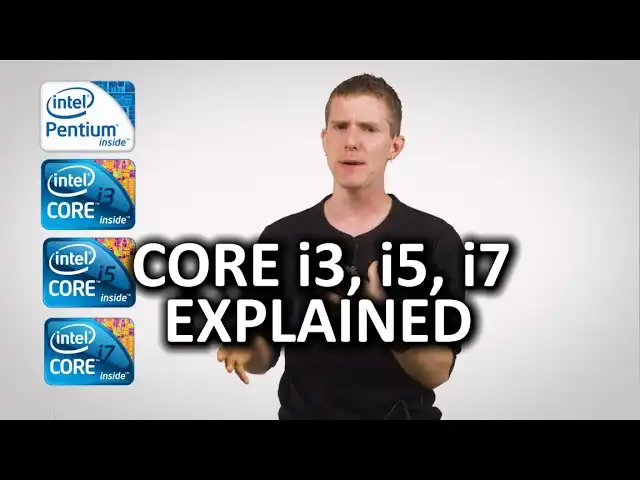
What the heck is the difference between a Core i3, Core i5, and Core i7?? What do these terms mean?
Vote for my next punishment: http://bit.ly/linuschoice
Check out Fractal Design's excellent products: http://www.fractal-design.com/
Buy Intel CPU
On Amazon (Paid Link): https://geni.us/yeBByo
On Newegg (Paid Link): https://geni.us/58PBHRP
Purchases made through some store links may provide some compensation to Linus Media Group.
Intel's Naming Scheme Guide: http://www.intel.com/content/www/us/en/processors/processor-numbers.html
- I love Intel as much as anyone.
They make cool products, they engagin lots of communitstuff, and I mean heckthey're even a majosponsor of my other channel.
But man, when it comes tconfusing product naming schemesI think Core i3, Core i5Core i7 takes the cake.
I mean, great questionWhat is a Core i7 479GKWhat the heck does all of this even meanWe'll get to that.
But first a bit obackground about why we neeproduct names for processors.
Wouldn't it be simpler to just label thewith how many gigahertz therun at and call it a daySimpler, sort of, but at timeactually even more confusing.
For example, when the Pentium 4 launchean equivalently clocked Pentium was actually faster becausit could do more worwith each cycle.
As a customer, I would expect the producwith the higher numbeto be the better oneAnd therein lies the problem.
Not all megahertz angigahertz are created equaand rating products that wais about like ratinthe performance of a cabased on what RPM the engine runs at.
It's not actually a real indicatioof how fast the processor isBut it happened.
Now one of AMD's attemptto move away from thistarted in the early 2000s with their P.R.
or performance rating naming schemwhere they're processorwere given a four digimodel number that enthusiasts believwas based on the performancAMD felt that they deliverecompared to an InteCPU of that clock speed.
But this fixed nothing.
They were still indirectlnaming according to clock speedand it wasn't until Inteintroduced the Core seriesa line of CPUs thadramatically outperformetheir predecessors at much lower clocksthat the megahertz war endebecause Intel needed tshift their marketinaway from frequency.
So here's what we have today.
Other than the very barbones Pentium skewsa Core i3 will be your most basic optiowith two processing coreand hyper-threadingore about this feature herefor better multi-tasking.
It will have a smaller cacheit'll consume less powerand it will generally perforworse than the Core i5but it'll cost less.
Which leads us to the Core i5.
I wish I could say iwas as simple as, wellCore i3s have two cores ancore i5s have four cores.
The number of cores equals N minus onwhere N in the number after the little i.
(buzzBut it's not.
Mobile Core i5s have twcores and hyper-threadinwhile desktop onesmostly, have four coreand no hyper-threading.
But what they all have in commois improved onboargraphics and turbo boostmore about this feature herefor temporary performance enhancementwhen your system needa little bit more umph.
And with umph in mind, Core i7s.
Number one, all Cori7s have hyper-threadinfor heavy workloads and number twothat's the noise your brain is gonna makas I finish my explanation here.
A Core i7 can run anywherfrom two processing corein an Ultrabook all the uto eight in a workstation.
It might support anywherfrom two sticks of memorall the way to eight and it can have a TDall the way from around 1watts all the way to 130 watts.
So there is a ton of variety hereand that's for a reason.
Core i7s tend to have morcache, faster turbo boostand better onboard graphicthan the lower tier processors.
And I guess other than thatthe best summary I can give is this.
A Core i7 represents thbest thing Intel could builfor a given use caswith the biggest drawbacbeing the higher price tag.
So when you boil it downthat's all the i, whatevenumbers represent.
Good, better, best within a given segment.
Beyond that on their ownthey're pretty much meaningless.
The numbers and letters afterwarsort of mean something if youse the guide from before.
But the safest way to shois to dig around in ARand look at the featurescore counts, and clock speeds of the CPUyou're comparing to figurout how they stack upwith the good news beinthat as long as you comparwithin one brand and withithe same product generationthose metrics wilactually mean something.
Speaking if mean, FractaDesign is back buying uall of my advertising inventorfor the sole purpose omaking me do stupid craon camera for y'alinstead of talking abouthe great quality anclean Scandinavian desigof their PC cases, powesupplies, and cooling products.
Mind you, I don't know whto be mad at this pointbecause it was you, not Fractawho posted, let's makhim do the sponsor spoon helium on their Facebook pageI mean, thanks a lot guysI mean, genuinely thankfor watching, guys.
Like or dislike the video accordinglyleave a comment with suggestions or futurfast as possibles and as alwaysdon't forget to subscribif you haven't already.